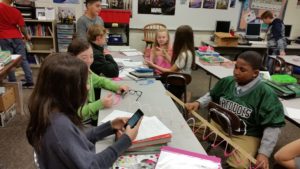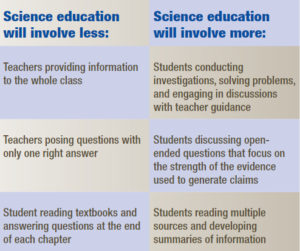My Science Students are Trying New Things–and We’re Learning Together
In our seventh-grade science class, we recently learned about energy waves. Students were asked the questions: Is there a relationship between frequency, wavelength, and speed? If so, what is it? If not, why? I could teach about frequency, wavelength, and speed by having students memorize definitions, teaching them the math formulas, and having them do practice problems—then testing them on it. Instead, I had students use the vocabulary, design a model, and plan an investigation in order to discover the math formulas.

Seventh graders in Lerchenfeldt’s class used a slinky, meter stick, and stopwatch to design an energy wave experiment.
As a society and as science educators, we are in a transition from a focus on knowledge itself to a focus on putting that knowledge to use. That shift is behind Michigan’s move to a new paradigm for science teaching, the Next Generation Science Standards (NGSS), adopted last year.
The United States’ ability to innovate depends on science education. Citizens are required to use critical thinking and communication skills in a global economy driven by advancements in Science, Technology, Engineering, and Math (STEM).
The potential payoffs for students are big. The National Science Foundation reports there are currently 2-3 million unfilled positions due to the lack of qualified candidates in the areas of STEM.
The NGSS emphasizes the eight practices essential to scientists and engineers in their workplaces and intertwines these practices with the core ideas students are learning in science class. They include asking questions and defining problems; developing and using models; planning and carrying out investigations; analyzing and interpreting data; using mathematics and computational thinking; constructing applications and designing solutions; engaging in argument from evidence; and obtaining, evaluating, and communicating information.
Michigan Science Teachers Test Driving “Next Gen” Standards
When students are engaged in these practices, they learn how scientific knowledge is developed and how it is linked to engineering and other problem-solving fields of thinking.
In my energy waves lesson, the class designed an investigation for small groups to carry out. Then each small group developed a model of a wave using a slinky, meter stick, and stopwatch to measure frequency, wavelength, and speed. Students—not the teacher—determined how to measure the time it takes for the wave to travel down the length of the slinky and back.
 All students collected data and recorded their observations. They analyzed the data and computed averages in search of a mathematical pattern or proportional relationship.
All students collected data and recorded their observations. They analyzed the data and computed averages in search of a mathematical pattern or proportional relationship.
I was impressed with their organized data tables and graphs. If students found a mathematical relationship, they were asked to construct an equation or formula to compute quantities.
In their conclusion, students had to answer the investigation questions and write an argument for their claim supported by evidence from their data. Each small group had time to discuss and communicate their results to the entire class.
Many of the small groups discovered a cause-and-effect relationship between frequency, wavelength, and speed. Those who did not figure it out on their own did understand it after the reporting out and whole-class discussion.
That’s an important point to make: This is not a magic solution for every student to get the “right” answer immediately. However, I believe my students understood more deeply what I was teaching, because they could apply abstract concepts back to what they saw with the slinky.
Engaging students in scientific practice also makes reading more relevant. As my seventh graders set out to investigate the properties of waves, they read “What are Waves?” to guide their thinking. As they did the work of exploring the interactions of frequency, wavelength, and speed—looking for patterns and relationships—we read an article titled “Wave Properties.”
Students were more engaged in the reading since they were seeking answers to real questions, which makes it easier to embed Common Core State Standards for Literacy into science teaching.
As the NGSS begin to take the focus off rote memorization, reading, writing and critical thinking will become fundamental skills in a science class—just as they are in a world of 21st century problems that need solving.
That means we need to teach young people how to read and think critically by modeling the strategies we expert readers use to comprehend science text—skills that will be paramount in their lives as citizens and participants in the world.
Was my lesson plan perfect? No. As always, I’ve reflected on ways to make it better next time—for example, by assessing individual student understanding through some kind of visible (active) response to questions, differentiating my instruction for individuals who need re-teaching, and offering reading selections at varied readability levels.
Change is messy, and I am shifting my practice. Teachers beginning the transition to the NGSS should expect to have some trial-and-error, but that is appropriate. After all, trial-and-error is the scientific way.



Comments
Post a Comment